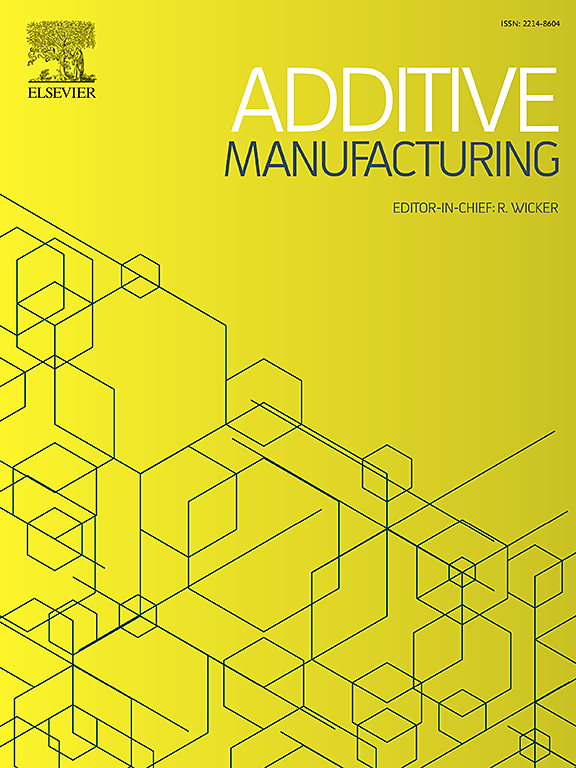Achieving high strength Al-Li alloy with minimized element evaporation by wire-arc directed energy deposition
IF 11.1
1区 工程技术
Q1 ENGINEERING, MANUFACTURING
引用次数: 0
Abstract
Porosity defects and lithium evaporation remain critical challenges in the wire-arc directed energy deposition (WA-DED) of Al-Li alloys. This study develops and validates a dual-surface Gaussian heat source model specifically tailored to the gas tungsten arc-based DED (GTA-DED) process, enabling accurate thermal field simulations. By coupling these simulations with Gaussian process regression (GPR), we systematically investigate the influence of key processing parameters on the deposition quality of AA2195 Al-Li alloy. A novel feature parameter system is introduced to quantitatively evaluate lithium loss—measured at a minimized rate of 1.6 %—and predict dimensional accuracy, which guides the identification of an optimized process window with enhanced formability. Subsequent T8 heat treatment, chosen for its effectiveness in promoting precipitate strengthening, drives microstructural evolution marked by the dissolution of intergranular Cu/Mg-rich phases and the precipitation of dense nano-scale T1(Al2CuLi) phases. This transformation leads to a significant increase in yield strength, reaching 554.5 MPa. Despite these improvements, residual defects such as hydrogen-induced pores and shrinkage cavities act as stress concentrators, limiting elongation to 2.2 %. The interplay between strength and ductility is further elucidated through detailed analysis of pore nucleation mechanisms and microtexture evolution. These findings provide critical theoretical insights and empirical data to advance the industrial application of WA-DED processing for Al-Li alloys.
采用线弧定向能沉积法制备高强度铝锂合金,使元素蒸发最小化
多孔性缺陷和锂离子蒸发是铝锂合金线弧定向能沉积(WA-DED)的关键问题。本研究开发并验证了专为基于气体钨电弧的DED (GTA-DED)工艺量身定制的双表面高斯热源模型,实现了精确的热场模拟。通过将这些模拟与高斯过程回归(GPR)相结合,系统地研究了关键工艺参数对AA2195 Al-Li合金沉积质量的影响。介绍了一种新的特征参数系统,用于定量评价以最小速率1.6 %测量的锂损耗,并预测尺寸精度,指导确定具有增强成形性的优化工艺窗口。随后的T8热处理因其促进析出相强化的效果而被选择,从而推动了显微组织的演变,其特征是晶间富Cu/ mg相的溶解和致密纳米级T1(Al2CuLi)相的析出。这种转变导致屈服强度显著提高,达到554.5 MPa。尽管有这些改进,但残余缺陷,如氢致气孔和缩孔,作为应力集中剂,将伸长率限制在2.2 %。通过对孔隙成核机制和微观织构演化的详细分析,进一步阐明了强度与延性之间的相互作用。这些发现为推进Al-Li合金的WA-DED加工的工业应用提供了重要的理论见解和经验数据。
本文章由计算机程序翻译,如有差异,请以英文原文为准。
求助全文
约1分钟内获得全文
求助全文
来源期刊

Additive manufacturing
Materials Science-General Materials Science
CiteScore
19.80
自引率
12.70%
发文量
648
审稿时长
35 days
期刊介绍:
Additive Manufacturing stands as a peer-reviewed journal dedicated to delivering high-quality research papers and reviews in the field of additive manufacturing, serving both academia and industry leaders. The journal's objective is to recognize the innovative essence of additive manufacturing and its diverse applications, providing a comprehensive overview of current developments and future prospects.
The transformative potential of additive manufacturing technologies in product design and manufacturing is poised to disrupt traditional approaches. In response to this paradigm shift, a distinctive and comprehensive publication outlet was essential. Additive Manufacturing fulfills this need, offering a platform for engineers, materials scientists, and practitioners across academia and various industries to document and share innovations in these evolving technologies.
 求助内容:
求助内容: 应助结果提醒方式:
应助结果提醒方式:


